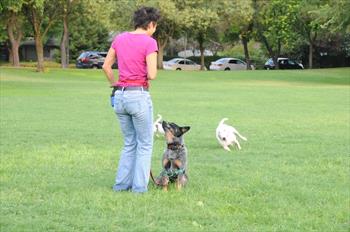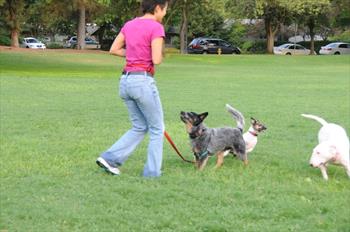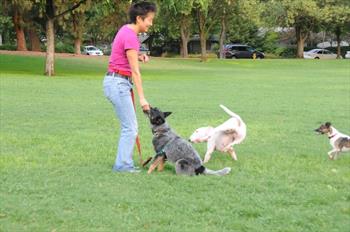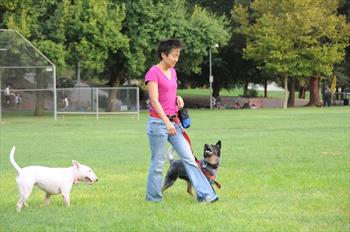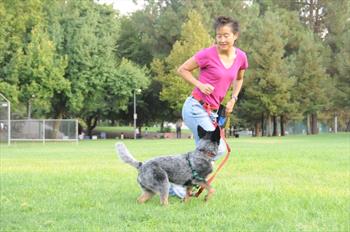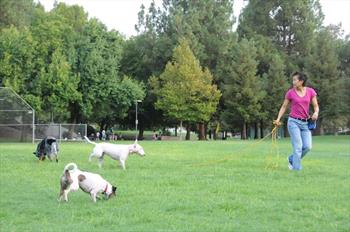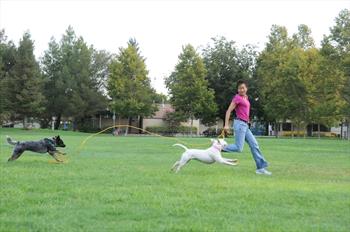My dog, Milo, loves to explore at the off-leash park but, when it’s time to go home, it takes me 10 to 20 minutes to catch him to put him back on leash. What should I do?
Rover loves to rough-house with other dogs but sometimes their owners get mad at me. I think he’s playing so they shouldn’t worry, but they say their dogs don’t like it. If I don’t leave the park, then they do. How can I train Rover to play more calmly? He is also reactive to dogs when on leash and will bark and lunge at them. He’s almost caused me to fall a few times because he’s lunged so suddenly.
Pogo loves to jump on and run into people at the park and he’s knocked his share of people down. I think he’s even gaining a reputation for doing this and people are starting to tell me I have to put him on leash. Is there hope for him?
The answer to all of these questions is the same. Before dogs are allowed to be off-leash at any park, you should first train a fantastic come when called so that you can call them before they get too excited and before they are rude.
For many people, training a reliable recall is a mystery but, once you know the routine, it’s actually both simple and straightforward—even to call him away before he jumps on a sprinting dog, steals another dog’s toy, or springs off of his favorite human friend. As an added benefit, this come when called will not only help your dog at the park but, because your dog will be less likely to get overly aroused or to spark an aggressive response from others dogs, it will also affect his behavior and response to dogs in other situations, such as when walking on leash.
The come when called starts with two easy exercises you can do at home:
- The Say Please by Sitting followed by repeat sits going backwards
- The repeat sits when you run to the side.
The following video demonstrates these exercises.
Say Please by Sitting: Part II
Once your dog knows these games well in low distraction situations such as in the house, it’s time to graduate to more challenging scenarios outside.
That first outdoor scenario may be in front of your house, at the park with few dogs, just outside the dog park or even inside the dog park. It depends on the dog. The general rule is you should only perform these exercises in locations where you can have fantastic success and then work towards more difficult situations.
Here’s an example of what it looks like when you’re ready to work at the dog park. The goal is to first get your dog focused on you while she’s on leash. If she won’t focus on you on leash, she’s almost certain to blow you off when she’s off leash. So these early steps are essential.
Step 1: The first step is to make sure that while your dog is still on her regular 6-foot leash, you can easily get her focus on you with the distractions. Here I’m working on repeat sits backwards. Notice, this dog is focused on me even with dogs running around her. If this level of distraction is too high, I can move to the side of the park where the dogs are far away.
I start with her sitting and give treats with lightening fast speed.
Then I suddenly sprint backwards so she wants to sprint after me.
Before she catches up, I stop and she automatically sits for more treats. I’ll repeat this a number of times in rapid succession so she stays focused on this fun game.
Now I can also heel her around the area with dogs.
Step 2: Add in “suddenly settle” I want to be sure to also add sudden running to the side and stopping. The goal is that I make the “sit and focus on me” game even more fun by adding sudden starts, stops and speed in between.
Your dog can be sitting or heeling next to you at the start.
Suddenly sprint to the side so she follows you in play mode.
Then, before she has a chance to run past you or before she gets bored, stop and reward her for sitting.
If she’s good at focusing on you for both of these exercises, now you have a way to ensure that she’s calm and focused when entering the park instead of rushing and pouncing on other dogs or bowling other dogs over. It also means you’re much more likely to be able to get her to come when you call since you’ve established you are fun, even when compared to other dogs at the park.
Come when Called on Long Leash
For this portion of the training, use a long leash (15–20 feet) and attach it to your dogs’ flat collar or better yet, a front-attaching harness (such as the Easy-Walk harness or a Freedom Harness). First, remember to work in an area where you can be successful. In fact, you may need to start at home inside the house or in the yard. Once you graduate to the park, you may start at the edge of the park first, or if it’s fenced, right outside the fenced part.
This photo shows the dog attached to a long leash. I’m getting ready to do a come when called so I’m near the end of the leash and the leash has very little slack.
Then I call her and immediately sprint away from her. This is her cue to race after me.
Note: I’m going fast enough that my dog is really racing to catch up and so is the dog that’s playing off-leash. If I don’t go fast enough, especially at the start, my dog will think I’m boring and won’t want to interrupt her task to come. Or she’ll think she has time to sight see and then still head over to get a treat. My goal is for my dog to think the exercise is so fun she always sprints to catch up to me.
Before your dog catches up to you, stop so she knows to stop too instead of running by.
Then reward her with one treat for sitting and additional treats for remaining seated and focused on you. Then release her to wander and explore and go back to whatever safe behavior she was enjoying before. This last bit, where she is sometimes rewarded by doing whatever safe behavior she was enjoying before, can be really important when that activity is super high value because it teaches her that you won’t take her fun away, rather you are just creating an equally fun intermission.
What about other dogs interfering?
Sometimes you have other park dogs that crowd you or jump on you when you have food. These are the same dogs that will also crowd and jump on you when you have a toy or when you just look more interesting then their own humans. If their owners won’t help you by calling their dog away or their dog has no recall and the owner doesn’t care, one option is to ignore them and focus on moving fast enough to keep your own dog focused. Often the dogs will just go away after they learn there’s no food for them.
For those dogs that are persistent, you can also elect just to train them since their owners don’t or won’t. Lure the crowding dog into a sit and reward frequently enough so he remains seated instead of getting impatient and jumping on you. In between treats, reward your own dog so that your own dog is learning that good things happened when he’s polite around the other dog. The trick here is the rate of reward for either dog.
Note that you can always inform the owner first that you are going to train their dog so he won’t crowd or jump on you and your dog.
See A Come When Called in Action
Don’t think a dog can come when called in high distractions such as at a dog park with toys, dogs and other fun distractions?
Here’s a video of my dog Jonesy heeling in order to have a chance to chase squirrels. This is day 5 of his squirrel training. After he gets the opportunity to run to the squirrel, he comes back when I call.
Here’s additional video of two small dogs playing. Note that the dogs are happy. They also stop occasionally, so they don’t get overly aroused and no one gets bounced around like a basketball. If they didn’t add in these stops on their own, the owner would need to call them apart before they got too worked up.
It’s Really That Simple
Yes, it really is that simple. The trick is starting at home and building up to more distracting situations after first establishing that you are fun. Make sure you practice 20 times each outing; never call your dog’s name when you aren’t ready to run. Our goal is to develop a habit that when she hears her name she just automatically turns and sprints to you without thinking. And if you stick with this plan regularly, you can often train a fantastic come when called in just a week or two.
Now you have the tools to call your dog before she gets overly aroused or rushes the other dog, or before a dog has a chance to rush her. It will make all your dog park and other dog encounters safer and more enjoyable.


